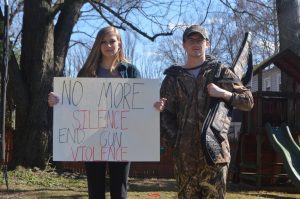Con:
April 9, 2018
Following the Marjory Stoneman Douglas HS shooting, the gun control debate is once again dominating the nation’s discourse immediately following the tragedy, but this time it has remained in the headlines. The MSDHS shooting was a heartbreaking tragedy that calls for immediate action to combat gun violence that is plaguing society. However, banning assault weapons, such as the AR-15, is not the solution.
The Colt AR-15 that the alleged shooter Nicolas Cruz used, is a semi-automatic military style assault rifle. It is also the most popular type of assault rifle in the U.S. While it is difficult to pinpoint the exact number of owned AR-15s in the country, the National Shooting Sports Foundation estimates between five and 10 million AR-15s are owned in the U.S. The weapon is popular among small game hunters for its versatility and accuracy.
While the current background check system can always be improved, anyone who passes the extensive check is deemed capable of handling a firearm and there is no reason to stop them from obtaining a weapon. Such an act would be a clear infringement on their second amendment rights.
Most of the focus in the recent gun control debate has been on the weapon itself. The real problem is how to keep weapons out of the hands of people who are dangerous to themselves and others. The Parkland shooter exhibited several warning signs. As an orphan who lost both his step parents, Cruz lacked a consistent support system. He also suffered from depression, was expelled for bringing a knife to school and had an abusive and violent history. All of the various adults and agencies who flagged Cruz’s behavior need to act on that knowledge so people like him never have access to a weapon of any kind.
Another issue with a narrow focus on a weapon’s ban is that like anything else, if the AR-15 is banned from the regulated market it will emerge on the black market. This is what fueled the illegal alcohol trade during prohibition and the current illegal drug trade. The effects of illegal gun trade are already evident in cities like Chicago, which has some of the stiffest gun regulations in the country and one of nation’s highest gun homicide rates. The death toll as a result of gun violence was around 25 per 100,000 residents in 2016. If regulation is increased to the extreme degree of banning firearms, this market will grow and more weapons will be in the hands of criminals.
There is no perfect system in place in any state in the U.S. for gun control. However, a combination of various policies can create a positive compromise. For example in New York the AR-15 is legal, while attachments and variations to the weapon such as adjusted stocks, muzzles and pistol handles are prohibited. New York has the fourth lowest gun death rate per 100,000. In Hawaii, a 21-year-old gun owner must acquire a permit from the county, go through a criminal background check and a mental screening that includes drug or alcohol addiction and psychiatric diagnosis. Hawaii’s firearm death rate is three times lower than the national average (3.6 to 11.1 according to the CDC).
Banning the AR-15 is like putting a band-aid on a broken arm. The problem with gun violence goes beyond the weapons themselves. To stop gun violence the country needs to invest more money in mental health screenings and continue the discussion that started at MSDHS and translate it into lasting legislative action.




